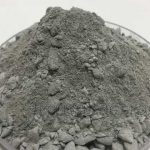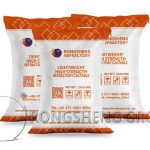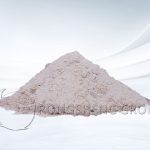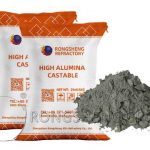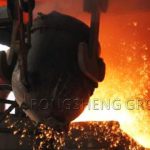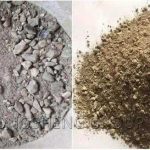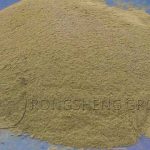Lightweight and high-strength refractory materials, using microporous mullite, mullite fine powder, alumina powder, alumina hollow balls and silica powder as raw materials, and cement as binder, were prepared to prepare lightweight mullite castables. The effect of the amount of alumina hollow balls added (addition mass fraction was 0, 3%, 6% and 9% respectively) on the properties of mullite castables. Alumina hollow balls can increase the porosity of the sample and promote the formation of mullite phase by alumina powder and silica powder. The problem that the mechanical properties of the sample are greatly reduced due to the increase of apparent porosity is solved. With the increase of the amount of alumina hollow balls added, the apparent porosity of the sample increases significantly, the bulk density decreases, the thermal conductivity decreases significantly, the thermal shock resistance increases, and the strength decreases less. When the addition amount of alumina hollow balls is 9% (w), the apparent porosity of the sample after heat treatment at 1 400℃ is higher, the bulk density and thermal conductivity are lower, but the strength at room temperature is still high.
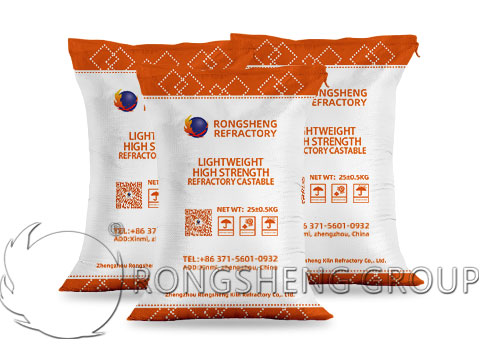
Lightweight High-Strength Mullite Castable
Mullite castable has excellent properties such as high refractoriness under load, good thermal shock resistance, and strong erosion resistance. It is widely used in industrial furnace linings, ladle covers, and tundish linings. However, dense aggregates and matrix lead to high thermal conductivity of castables, which results in large heat loss and high energy consumption of high-temperature thermal equipment. Therefore, to achieve lightweight castables, it is necessary to develop refractory castables with high temperature resistance, low thermal conductivity, high strength, and good thermal shock resistance.
Lightweight castables can be achieved through lightweight aggregates or lightweight matrices. Aggregates are the main contributors to the strength of castables. Only lightweight aggregates with good performance can produce high-strength and low-thermal-conductivity castables. Porous mullite microspheres, α-Al2O3 and SiO2 micropowders are used as the main raw materials, silica sol is used as a binder, and AlF3·H2O and V2O5 are used as additives. A large number of whiskers were generated in the sample, thus preparing a mullite castable with high strength and low thermal conductivity. Using spherical lightweight mullite aggregate, mullite fine powder and kyanite as the main raw materials, a lightweight mullite castable with good fluidity, a bulk density of 1.73 g/cm3, a thermal conductivity of 0.580 W/(m·K) and good mechanical properties was obtained.
In the matrix part, lightweight design can also be carried out, that is, pore-forming agents are added to the matrix. Polystyrene foam balls were added to the corundum-mullite castable. When the addition amount was 50% of the total volume of the slurry, the porosity of the castable was 61% and the thermal conductivity was as low as 0.220 W·(m·K)-1. Alumina hollow spheres are often used as aggregates to prepare porous ceramics due to their high refractoriness and low thermal conductivity. But it is also a new type of inorganic pore-forming agent. When 30% (w) of alumina hollow spheres are added to mullite castable, the volume density of the castable is reduced to 1.96 g·cm-3, and the thermal conductivity is 0.890 W·(m·K)-1.
In summary, lightweight design of matrix and aggregate can obtain castable with lower thermal conductivity while maintaining good mechanical properties, thereby reducing the energy consumption of high-temperature thermal equipment.
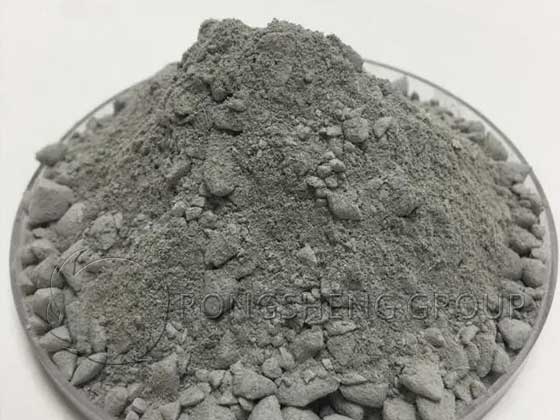
Effect of the Amount of Alumina Hollow Balls Added and Heat Treatment Temperature on the Properties of Mullite Castables
Using microporous mullite, mullite fine powder, alumina powder, and silica powder as the main raw materials, alumina hollow balls as pore-forming agents, and cement as binders, the effects of the amount of alumina hollow balls added and heat treatment temperature on the properties of mullite castables were studied.
Phase composition
The sample without the addition of alumina hollow balls mainly contains calcium feldspar, mullite, corundum, etc., while the diffraction peak of the mullite phase in the sample with 9% (w) of alumina hollow balls added is enhanced. This is because the raw materials such as alumina powder and silica powder in the matrix react at high temperature to generate products such as mullite and calcium feldspar. At the same time, an Al2O3-rich zone is formed at the interface between the alumina hollow balls and the matrix, thereby increasing the amount of mullite generated.
Physical properties at room temperature
With the increase of the amount of alumina hollow balls added, the apparent porosity of the sample gradually increases, while its volume density decreases. When the alumina hollow spheres were not added, the porosity of the castable was 23.2%, indicating that microporous mullite can also provide a certain porosity for the castable. When the addition amount of alumina hollow spheres was 9% (w), the apparent porosity was the highest, reaching 43.6%, and the volume density was the lowest, at 1.61 g·cm-3. This is because the lightweight porous structure of the alumina hollow spheres provides a large number of pores for the castable. At the same time, the alumina hollow spheres promote the formation of mullite, causing volume expansion and increasing the porosity of the castable.
With the increase of heat treatment temperature and the increase of the amount of alumina hollow spheres added, the heating permanent linear change of the sample is increasing. This is because the alumina hollow spheres react with part of the matrix to generate mullite, causing volume expansion. As the temperature increases, the amount of mullite generated increases, and the heating permanent linear change of the sample also increases. In addition, the interface area between the alumina hollow spheres and the matrix is an Al2O3-rich area. The temperature of the liquid phase in this area is higher than that in other areas, and the liquid phase shrinkage rate is small, resulting in an increase in the heating permanent linear change of the sample.
The room temperature strength of the sample decreases with the increase of the amount of alumina hollow spheres added. At the same time, with the increase of heat treatment temperature, the room temperature strength of the sample gradually increases. When the amount of alumina hollow spheres added is 9% (w), the room temperature flexural strength and room temperature compressive strength of the sample after 1 400 ℃ heat treatment are 11.9 and 47.1 MPa, respectively. The strength of the sample after drying at 110 ℃ is mainly provided by the intrinsic strength of the mullite aggregate. However, the bonding strength between the matrix and the fine powder is not high, so the room temperature compressive strength is low at this time. After high temperature treatment at 1 400 ℃, the sintering effect between the aggregate and the fine powder makes the particles in the castable more tightly bonded, and the alumina fine powder and the silica fine powder react to form mullite, which improves the strength of the castable. However, since the alumina hollow spheres replace part of the aggregate, the porosity of the sample is increased, resulting in a decrease in mechanical strength. However, the hollow alumina spheres increase the amount of mullite generated, and the porous structure of the hollow alumina spheres can hinder crack propagation, so its strength decreases less.
Thermal shock resistance
With the increase of the amount of hollow alumina spheres added, the room temperature flexural strength of the sample after 5 thermal shocks basically decreases, but the strength retention rate of the sample gradually increases. This is because the hollow alumina spheres are lightweight and porous, and the microcracks in their pores can effectively alleviate the expansion of cracks, thereby improving the thermal shock resistance of the castable. In addition, the micropores in the microporous mullite aggregate are also conducive to increasing the crack propagation path and improving the thermal shock resistance of the castable.
Thermal conductivity
With the increase of the amount of hollow alumina spheres added, the thermal conductivity of the sample decreases. When the amount of hollow alumina spheres added is 9% (w), the thermal conductivity of the sample at 1 000 ℃ decreases to 0.380 W·(m·K)-1. This is due to the porous structure of the hollow alumina spheres, which increases the porosity of the sample and reduces the thermal conductivity. Microporous mullite itself also has many pores, which can also reduce the thermal conductivity of the sample.
Through the principle of closest packing, the component ratio of the castable is reasonably optimized to solve the problem of the difficulty in combining alumina hollow balls and lightweight mullite aggregate. With the increase of the amount of alumina hollow balls added, the apparent porosity of the sample increases significantly, the bulk density decreases, the thermal conductivity decreases significantly, the thermal shock resistance increases, and the strength decreases. When the addition amount of alumina hollow balls is 9% (w), the apparent porosity of the sample after heat treatment at 1 400 ℃ is 43.6%, and the bulk density is as low as 1.61 g·cm-3. The thermal conductivity at 1 000 ℃ is as low as 0.380 W·(m·K)-1, and the strength is still high. The room temperature flexural strength and room temperature compressive strength are 11.9 and 47.1 MPa, respectively. In the context of energy conservation and emission reduction, it not only saves the production cost, but also reduces energy consumption.

